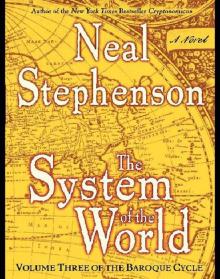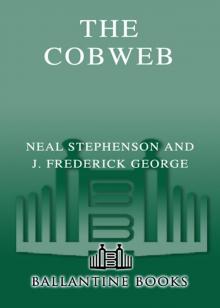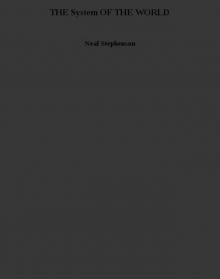- Home
- Neal Stephenson
Mother Earth Mother Board Page 12
Mother Earth Mother Board Read online
Page 12
We have all been raised to think of the telephone as a vast improvement on the telegraph, as the steamship was to the sailing ship or the electric lightbulb to the candle, but from a hacker tourist's point of view, it begins to seem like a lamentable wrong turn. Until Bell, all telegraphy was digital. The multiplexing system he worked on was purely digital in concept even if it did make use of some analog properties of matter (as indeed all digital equipment does). But when his multiplexing scheme went sour, he suddenly went analog on us.
Fortunately, the story has a happy ending, though it took a century to come about. Because analog telephony did not require expertise in Morse code, anyone could take advantage of it. It became enormously popular and generated staggering quantities of revenue that underwrote the creation of a fantastically immense communications web reaching into every nook and cranny of every developed country.
Then modems came along and turned the tables. Modems are a digital hack on an analog technology, of course; they take the digits from your computer and convert them into a complicated analog waveform that can be transmitted down existing wires. The roar of white noise that you hear when you listen in on a modem transmission is exactly what Bell was originally aiming for with his reeds. Modems, and everything that has ensued from them, like the World Wide Web, are just the latest example of a pattern that was established by Kelvin 140 years ago, namely, hacking existing wires by inventing new stuff to put on the ends of them.
It is natural, then, to ask what effect FLAG is going to have on the latest and greatest cable hack: the Internet. Or perhaps it's better to ask whether the Internet affected FLAG. The explosion of the Web happened after FLAG was planned. Taketo Furuhata, president and CEO of IDC, which runs the Miura station, says: "I don't know whether Nynex management foresaw the burst of demand related to the Internet a few years ago - I don't think so. Nobody - not even AT&T people - foresaw this. But the demand for Internet transmission is so huge that FLAG will certainly become a very important pipe to transmit such requirements."
John Mercogliano, vice president - Europe, Nynex Network Systems (Bermuda) Ltd., says that during the early 1990s when FLAG was getting organized, Nynex executives felt in their guts that something big was going to happen involving broadband multimedia transmission over cables. They had a media lab that was giving demos of medical imaging and other such applications. "We knew the Internet was coming - we just didn't know it was going to be called the Internet," he says.
FLAG may, in fact, be the last big cable system that was planned in the days when people didn't know about the Internet. Those days were a lot calmer in the global telecom industry. Everything was controlled by monopolies, and cable construction was based on sober, scientific forecasts, analogous, in some ways, to the actuarial tables on which insurance companies predicate their policies.
When you talk on the phone, your words are converted into bits that are sent down a wire. When you surf the Web, your computer sends out bits that ask for yet more bits to be sent back. When you go to the store and buy a Japanese VCR or an article of clothing with a Made in Thailand label, you're touching off a cascade of information flows that eventually leads to transpacific faxes, phone calls, and money transfers.
If you get a fast busy signal when you dial your phone, or if your Web browser stalls, or if the electronics store is always low on inventory because the distribution system is balled up somewhere, then it means that someone, somewhere, is suffering pain. Eventually this pain gets taken out on a fairly small number of meek, mild-mannered statisticians - telecom traffic forecasters - who are supposed to see these problems coming.
Like many other telephony-related technologies, traffic forecasting was developed to a fine art a long time ago and rarely screwed up. Usually the telcos knew when the capacity of their systems was going to be stretched past acceptable limits. Then they went shopping for bandwidth. Cables got built.
That is all past history. "The telecoms aren't forecasting now," Mercogliano says. "They're reacting."
This is a big problem for a few different reasons. One is that cables take a few years to build, and, once built, last for a quarter of a century. It's not a nimble industry in that way. A PTT thinking about investing in a club cable is making a 25-year commitment to a piece of equipment that will almost certainly be obsolete long before it reaches the end of its working life. Not only are they risking lots of money, but they are putting it into an exceptionally long-term investment. Long-term investments are great if you have reliable long-term forecasts, but when your entire forecasting system gets blown out of the water by something like the Internet, the situation gets awfully complicated.
The Internet poses another problem for telcos by being asymmetrical. Imagine you are running an international telecom company in Japan. Everything you've ever done, since TPC-1 came into Ninomiya in '64, has been predicated on circuits. Circuits are the basic unit you buy and sell - they are to you what cars are to a Cadillac dealership. A circuit, by definition, is symmetrical. It consists of an equal amount of bandwidth in each direction - since most phone conversations, on average, entail both parties talking about the same amount. A circuit between Japan and the United States is something that enables data to be sent from Japan to the US, and from the US to Japan, at the same rate - the same bandwidth. In order to get your hands on a circuit, you cut a deal with a company in the States. This deal is called a correspondent agreement.
One day, you see an ad in a magazine for a newfangled thing called a modem. You hook one end up to a computer and the other end to a phone line, and it enables the computer to grab a circuit and exchange data with some other computer with a modem. So far, so good. As a cable-savvy type, you know that people have been hacking cables in this fashion since Kelvin. As long as the thing works on the basis of circuits, you don't care - any more than a car salesman would care if someone bought Cadillacs, tore out the seats, and used them to haul gravel.
A few years later, you hear about some modem-related nonsense called the World Wide Web. And a year after that, everyone seems to be talking about it. About the same time, all of your traffic forecasts go down the toilet. Nothing's working the way it used to. Everything is screwed up.
Why? Because the Web is asymmetrical. All of your Japanese Web customers are using it to access sites in the States, because that's where all the sites are located. When one of them clicks on a button on an American Web page, a request is sent over the cable to the US. The request is infinitesimal, just a few bytes. The site in the States promptly responds by trying to send back a high-resolution, 24-bit color image of Cindy Crawford, or an MPEG film of a space shuttle mission. Millions of bytes. Your pipe gets jammed solid with incoming packets.
You're a businessperson. You want to make your customers happy. You want them to get their millions of bytes from the States in some reasonable amount of time. The only way to make this happen is to purchase more circuits on the cables linking Japan to the States. But if you do this, only half of each circuit is going to be used - the incoming half. The outgoing half will carry a miserable trickle of packets. Its bandwidth will be wasted. The correspondent agreement relationship, which has been the basis of the international telecom business ever since the first cables were laid, doesn't work anymore.
This, in combination with the havoc increasingly being wrought by callback services, is weird, bad, hairy news for the telecom monopolies. Mercogliano believes that the solution lies in some sort of bandwidth arbitrage scheme, but talking about that to an old-time telecrat is like describing derivative investments to an old codger who keeps his money under his mattress. "The club system is breaking down," Mercogliano says.
Somewhere between50° 54.20062' N, 1° 26.87229 W and50° 54.20675' N, 1° 26.95470 WCable Ship Monarch, Southampton, England
John Mercogliano, if this is conceivable, logs even more frequent-flier miles, to even more parts of the planet, than the cable layers we met on Lan Tao Island. He lives in London, his office is in Ams
terdam, his territory is Europe, he works for a company headquartered in Bermuda that has many ties to the New York metropolitan area and that does business everywhere from Porthcurno to Miura. He is trim, young-looking, and vigorous, but even so the schedule occasionally takes its toll on him, and he feels the need to just get away from his job for a few days and think about something - anything - other than submarine cables. The last time this feeling came over him, he made inquiries with a tourist bureau in Ireland that referred him to a quiet, out-of-the-way place on the coast: a stately home that had been converted to a seaside inn, an ideal place for him to go to get his mind off his work. Mercogliano flew to Ireland and made his way overland to the place, checked into his room, and began ambling through the building. The first thing he saw was a display case containing samples of various types of 19th-century submarine cables. It turned out that the former owner of this mansion had been the captain of the Great Eastern, the first of the great deep-sea cable-laying ships.
The Great Eastern got that job because it was by a long chalk the largest ship on the planet at the time - so large that its utter uselessness had made it a laughingstock, the Spruce Goose of its day. The second generation of long-range submarine cables, designed to Lord Kelvin's specifications after the debacle of 1857, were thick and heavy. Splicing segments together in mid-ocean had turned out to be problematical, so there were good reasons for wanting to make the cable in one huge piece and simply laying the whole thing in one go.
It is easier to splice cables now and getting easier all the time. Coaxial cables of the last few decades took some 36 to 48 hours to splice, partly because it was necessary to mold a jacket around them. Modern cables can be spliced in more like 12 hours, depending on the number of fibers they contain. So modern cable ships needn't be quite as great as the Great Eastern.
Other than the tank that contains the cable, which is literally nothing more than a big round hole in the middle of the ship, a cable ship is different from other ships in two ways. One, it comes with a complement of bow and stern thrusters coupled to exquisitely sensitive navigation gear on the bridge, which give it unsurpassed precision-maneuvering and station-keeping powers. In the case of Monarch, a smaller cable repair ship that we visited in Southampton, England, there are at least two differential GPS receivers, one for the bow and one for the stern - hence the two readings given at the head of this section. Each one of them reads out to five decimal places, which implies a resolution of about 1 centimeter.
Second, a cable ship has two winches on board. But this does not do justice to them, as they are so enormous, so powerful, and yet so nimble that it would almost be more accurate to say that a cable ship is two floating winches. Nearly everything that a cable ship does reduces, eventually, to winching. Laying a cable is a matter of paying cable out of a winch, and repairing it, as already described, involves a much more complicated series of winch-related activities.
As Kelvin figured out the hard way, whenever you are reeling in a long line, you must first relieve all tension on it or else your reel will be crushed. The same problem is posed in reverse by the cable-laying process, where thousands of meters of cable, weighing many tons, may be stretched tight between the ship and the contact point on the seafloor, but the rest of the cable stored on board the ship must be coiled loosely in the tanks with no tension on them at all. In both cases, the cable must be perfectly slack on the ship end and very tight on the watery end of the winching machinery. Not surprisingly, then, the same machinery is used for both outgoing and incoming winch work.
At one end of the ship is a huge iron drum some 3 meters in diameter with a few turns of cable around it. As you can verify by wrapping a few turns of rope around a pipe and tugging, this is a very simple way to relieve tension on a line. It is not, however, very precise, and here, precise control is very important. That is provided by something called a linear engine, which consists of several pairs of tires mounted with a narrow gap between them (for you baseball fans, it is much like a pitching machine). The cable is threaded through this gap so that it is gripped on both sides by the tires. Monarch's linear engine contains 16 pairs of tires which, taken together, can provide up to 10 tons of holdback force. Augmented by the drums, which can be driven by power from the ship's main engines, the ultimate capacity of Monarch's cable engines is 30 tons.
The art of laying a submarine cable is the art of using all the special features of such a ship: the linear engines, the maneuvering thrusters, and the differential GPS equipment, to put the cable exactly where it is supposed to go. Though the survey team has examined a corridor many thousands of meters wide, the target corridor for the cable lay is 200 meters wide, and the masters of these ships take pride in not straying more than 10 meters from the charted route. This must be accomplished through the judicious manipulation of only a few variables: the ship's position and speed (which are controlled by the engines, thrusters, and rudder) andthe cable's tension and rate of payout (which are controlled by the cable engine).
One cannot merely pay the cable out at the same speed as the ship moves forward. If the bottom is sloping down and away from the ship as the ship proceeds, it is necessary to pay the cable out faster. If the bottom is sloping up toward the ship, the cable must come out more slowly . Such calculations are greatly complicated by the fact that the cable is stretched out far behind the ship - the distance between the ship and the cable's contact point on the bottom of the ocean can be more than 30 kilometers, and the maximum depth at which (for example) KDD cable can be laid is 8,000 meters. Insofar as the shape of the bottom affects what the ship ought to be doing, it's not the shape of the bottom directly below the ship that is relevant, but the shape of the bottom wherever the contact point happens to be located, which is by no means a straightforward calculation. Of course, the ship is heaving up and down on the ocean and probably being shoved around by wind and currents while all this is happening, and there is also the possibility of ocean currents that may move the cable to and fro during its descent.
It is not, in other words, a seat-of-the-pants kind of deal; the skipper can't just sit up on the bridge, eyeballing a chart, and twiddling a few controls according to his intuition. In practice, the only way to ensure that the cable ends up where it is supposed to is to calculate the whole thing ahead of time. Just as aeronautical engineers create numerical simulations of hypothetical airplanes to test their coefficient of drag, so do the slack control wizards of Cable & Wireless Marine use numerical simulation techniques to model the catenary curve adopted by the cable as it stretches between ship and contact point. In combination with their detailed data on the shape of the ocean floor, this enables them to figure out, in advance, exactly what the ship should do when. All of it is boiled down into a set of instructions that is turned over to the master of the cable ship: at such and such a point, increase speed to x knots and reduce cable tension to y tons and change payout speed to z meters per second, and so on and so forth, all the way from Porthcurno to Miura."
It sounds like it would make a good videogame," I said to Captain Stuart Evans after he had laid all of this out for me. I was envisioning something called SimCable. "It would make a good videogame," he agreed, "but it also makes a great job, because it's a combination of art and science and technique - and it's not an art you learn overnight. It's definitely a black art."
Cable & Wireless's Marine Survey department has nailed the slack control problem. That, in combination with the company's fleet of cable-laying ships and its human capital, makes it dominant in the submarine cable-laying world.
By "human capital" I mean their ability to dispatch weather-beaten operatives such as the Lan Tao Island crowd to difficult places like Suez and have them know their asses from their elbows. As we discovered on our little jaunt to Egypt, where we tried to rendezvous with a cable ship in the Gulf of Suez and were turned back by the Egyptian military, one doesn't just waltz into places like that on short notice and get stuff to happen.
In each
country between England and Japan, there are hoops that must be jumped through, cultural differences that must be understood, palms that must be greased, unwritten rules that must be respected. The only way to learn that stuff is to devote a career to it. Cable & Wireless has an institutional memory stretching all the way back to 1870, when it laid the first cable from Porthcurno to Australia, and the British maritime industry as a whole possesses a vast fund of practical experience that is the legacy of the Empire.
One can argue that, in the end, the British Empire did Britain surprisingly little good. Other European countries that had pathetic or nonexistent empires, such as Italy, have recently surpassed England in standard of living and other measures of economic well-being. Scholars of economic history have worked up numbers suggesting that Britain spent more on maintaining its empire than it gained from exploiting it. Whether or not this is the case, it is quite obvious from looking at the cable-laying industry that the Victorian practice of sending British people all over the planet is now paying them back handsomely.
The current position of AT&T versus Cable & Wireless reflects the shape of America versus the shape of the British Empire. America is a big, contiguous mass, easy to defend, immensely wealthy, and basically insular. No one comes close to it in developing new technologies, and AT&T has always been one of America's technological leaders. By contrast, the British Empire was spread out all over the place, and though it controlled a few big areas (such as India and Australia), it was basically an archipelago of outposts, let us say a network, completely dependent on shipping and communications to stay alive. Its dominance was always more economic than military - even at the height of the Victorian era, its army was smaller than the Prussian police force. It could coerce the natives, but only so far - in the end, it had to co-opt them, give them some incentive to play along. Even though the Empire has been dissolving itself for half a century, British people and British institutions still know how to get things done everywhere.

 Zodiac: The Eco-Thriller
Zodiac: The Eco-Thriller The Mongoliad: Book One
The Mongoliad: Book One Snow Crash
Snow Crash The Confusion: Volume Two of the Baroque Cycle
The Confusion: Volume Two of the Baroque Cycle The Rise and Fall of D.O.D.O.
The Rise and Fall of D.O.D.O. The Diamond Age: Or, a Young Lady's Illustrated Primer
The Diamond Age: Or, a Young Lady's Illustrated Primer The Big U
The Big U The System of the World: Volume Three of the Baroque Cycle
The System of the World: Volume Three of the Baroque Cycle The Cobweb
The Cobweb Reamde
Reamde Fall; or, Dodge in Hell
Fall; or, Dodge in Hell Interface
Interface Quicksilver
Quicksilver The Mongoliad: Book Three
The Mongoliad: Book Three Seveneves
Seveneves Atmosphæra Incognita
Atmosphæra Incognita In the Beginning...Was the Command Line
In the Beginning...Was the Command Line Anathem
Anathem The Rise and Fall of D.O.D.O.: A Novel
The Rise and Fall of D.O.D.O.: A Novel The Mongoliad: Book Two
The Mongoliad: Book Two Diamond Age or a Young Lady's Illustrated Primer
Diamond Age or a Young Lady's Illustrated Primer THE System OF THE WORLD
THE System OF THE WORLD The Mongoliad: Book One tfs-1
The Mongoliad: Book One tfs-1 Some Remarks: Essays and Other Writing
Some Remarks: Essays and Other Writing Zodiac
Zodiac Spew
Spew The Baroque Cycle: Quicksilver, the Confusion, and the System of the World
The Baroque Cycle: Quicksilver, the Confusion, and the System of the World The Diamond Age
The Diamond Age Reamde: A Novel
Reamde: A Novel In the Kingdom of Mao Bell
In the Kingdom of Mao Bell Mother Earth Mother Board
Mother Earth Mother Board Twelve Tomorrows - Visionary stories of the near future inspired by today's technologies
Twelve Tomorrows - Visionary stories of the near future inspired by today's technologies The Confusion
The Confusion The Great Simoleon Caper
The Great Simoleon Caper The Mongoliad: Book Three tfs-3
The Mongoliad: Book Three tfs-3